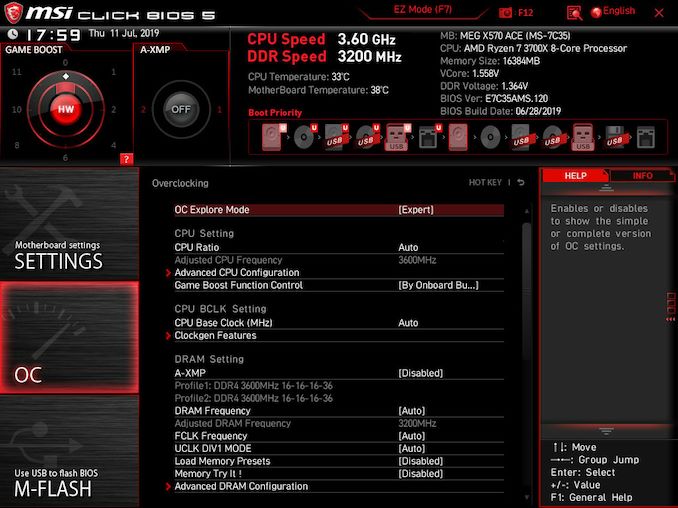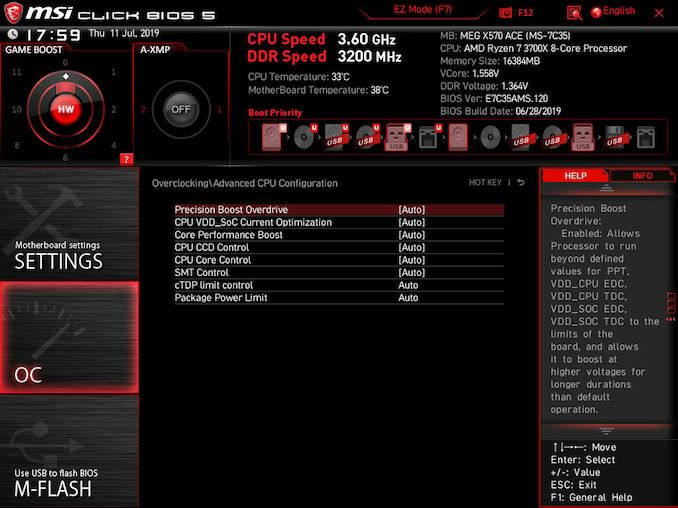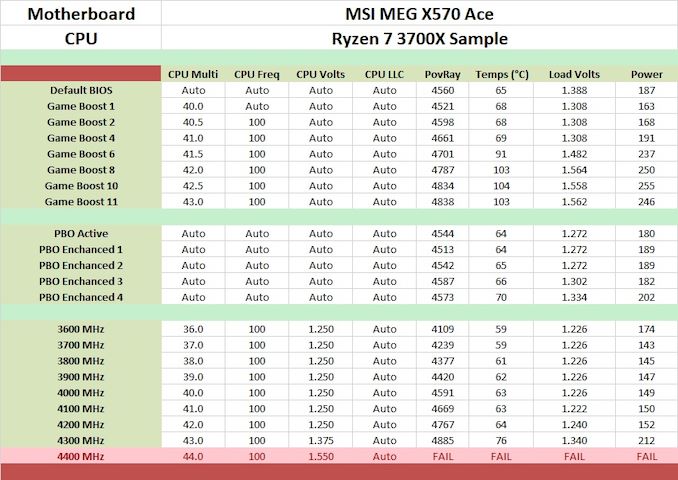The MSI MEG X570 Ace Motherboard Review: Ace in the Hole at $369
by Gavin Bonshor on July 18, 2019 11:00 AM EST- Posted in
- Motherboards
- AMD
- MSI
- AM4
- Zen 2
- Ryzen 3000
- X570
- MEG
- X570 Ace
- 3700X
- Ryzen 3700X
Overclocking Ryzen 3000
Experience with the MSI MEG X570 Ace
It's no secret that the general consensus of overclocking with the Ryzen 3000 series has been so far disappointing. Whether it be the limitations of the new 7 nm silicon or the insane temperatures that these processors run at when overclocked, or even at stock settings with the stock cooler, to unlock the full potential of these chips, better cooling methods such as premium AIOs and custom water cooling is needed.
Overclocking with the MSI MEG X570 Ace motherboard, there are three ways this can be achieved; within the firmware, with the simple, albeit effective tools inside the MSI Dragon Center application or with the comprehensive AMD Ryzen Master overclocking software. For the purpose of this review, we used the MSI Click BIOS 5 firmware which is very intuitive to use, and although this model was quite laggy, it still worked without issues. While the most commonly changed settings to overclock the processor include the CPU ratio which increases the frequency in increments of 100 MHz and the CPU VCore which increases the voltage pumped into the processor which not only generates extra heat but also increases power consumption.
In addition to the boost feature of the Ryzen 3000 processors, another AMD specific feature is called Precision Boost Overdrive or PBO. The three main variables that PBO works from including package power tracking (PPT), thermal design current (TDC), and the electrical design current (EDC). All three of these can be set within the firmware under the advanced section of the Precision Boost Overdrive menu, although MSI has included four different PBO profiles for users to select from. In addition to these are seven different Game Boost CPU overclocking profiles with each profile ranging from 4.0 GHz all cores up to 4.3 GHz all cores; these go up in increments of 50 MHz.
Overclocking Methodology
Our standard overclocking methodology is as follows. We select the automatic overclock options and test for stability with POV-Ray and OCCT to simulate high-end workloads. These stability tests aim to catch any immediate causes for memory or CPU errors.
For manual overclocks, based on the information gathered from the previous testing, starts off at a nominal voltage and CPU multiplier, and the multiplier is increased until the stability tests are failed. The CPU voltage is increased gradually until the stability tests are passed, and the process repeated until the motherboard reduces the multiplier automatically (due to safety protocol) or the CPU temperature reaches a stupidly high level (105ºC+). Our test bed is not in a case, which should push overclocks higher with fresher (cooler) air.
Overclocking Results
The 12+2 power delivery of the MSI MEG X570 Ace is one of the best we have seen from MSI in recent years and as a result, allowed us to manually overclock our Ryzen 7 3700X sample to 4.3 GHz with a set voltage of 1.375 V. Using the default load line calibration setting, this resulted in a load CPU VCore of 1.340 V which gives us a VDroop of 0.035 V in total. Of course, this can be alleviated by using a more aggressive LLC profile, but for the purposes of our testing, we leave this setting at auto. More voltage pumped into the CPU not only results in higher operating temperatures, but this also increases the overall power consumption.
Testing out each of MSI's seven Game Boost profiles did yield some interesting findings. First of all, each profile overvolted our Ryzen 3700X by a massive margin when you factor in what we achieved by using manual settings. Secondly, the three highest Game Boost profiles pumped insane amounts of CPU VCore in which in turn, made our 240mm AIO closed-loop cooler go into overdrive with temperatures in the triple digits. Outside of extreme overclocking, no Ryzen 3000 processor should be subjected to voltages of 1.562 V for a 4.3 GHz overclock on ambient cooling. Performance however was consistently higher with each of the profiles in our POV-Ray benchmark and by default with the Game Boost profiles, thermal throttling is disabled meaning that there is a trade-off between heat and performance. We also tested with PBO and found that performance was actually worse than the default settings, with MSI's four PBO profiles not really having much of an effect on performance; this leads us to believe for the most part, that PBO on Ryzen 3000 could do with a rework to make it more effective.













92 Comments
View All Comments
Targon - Thursday, July 18, 2019 - link
If you are looking to install a $500 CPU into a sub-$200 motherboard, you have a set of misplaced priorities. A low-end B350 motherboard may not have the VRMs to support the 105W processors, so you have to expect issues there. Also, many motherboard companies have been slacking when it comes to releasing AGESA 1.0.0.3ab based BIOS updates for older motherboards(Asus really needs to get its act together).29a - Thursday, July 18, 2019 - link
I wouldn't worry about stability or performance putting a 3700x in my $74 motherboard. You just need to make sure the CPU has been qualified by the vendor first and have a good quality power supply.Death666Angel - Friday, July 19, 2019 - link
"you have a set of misplaced priorities" Or maybe you don't do your research properly? Why should I spend money on features I don't use? A lot of sub $100 motherboards support the new 12 core and the VRMs are fine. Some will even support the 16 core and depending on air flow the VRM will still be fine. If you know what you are doing, there is no need to overspend on the motherboard "just to be safe".Some people also have different need than you. I have an mATX case and want to keep it (ITX is too restrictive and ATX is too large for my tastes). The most expensive mATX motherboards with an X370 or B450 (only one X470 board from AsRack for workstations) is the ASUS TUF 450M-Pro (sub $100) and that is probably worse than the Mortar line from MSI unless you need a very specific feature. I could go ITX but then lose 2 DIMM slots, M.2 support is more limited, VRM support suprisingly is pretty decent. But I also lose the possibility of using an extra x4 or x1 slot for future upgrades (more USB lanes, LAN card, SATA ports). I've had instances where the onboard LAN or a couple USB ports died. It's handy to have some expansion capabilities if you have the room. If I don't need the internal power, reset buttons, why pay for them? If I don't need guaranteed 4600+ MHz, why pay for it? If I don't need ALC1220, why pay for it? If I don't need more than 8 USB ports on the IO panel or more than 1 LAN port, why pay for it? Often times you get more features, but not necessarily better or more useful features when you step up in pricing. The blanket statement I quoted is really kind of ignorant.
jabber - Thursday, July 18, 2019 - link
Shhhh remember these sites have to justify their existence by pushing the concept of market churn even though most cases of tech were long since satisfied and we are largely just reheating leftovers for the past 10 years. These reviews really do cater to a ever dwindling number of tech users.satai - Thursday, July 18, 2019 - link
ECC support?Targon - Thursday, July 18, 2019 - link
There's been ECC support on motherboards since the first generation Ryzen showed up.satai - Friday, July 19, 2019 - link
Not every mobo has it official / was tested.Death666Angel - Friday, July 19, 2019 - link
The time it took to write those comments, you could have visited the website and look at the manual and provide a service to everyone.Here:
"Supports non-ECC UDIMM memory
Supports ECC UDIMM memory (non-ECC mode)
Supports un-buffered memory"
Jansen - Friday, July 19, 2019 - link
So that would be a no LOLDug - Thursday, July 18, 2019 - link
Please test the components of the motherboard, it's a motherboard review. Everyone can stick a cpu on the board and run tests. But we want to see if there are any issues or performance issues with the USB, network, sound, etc.